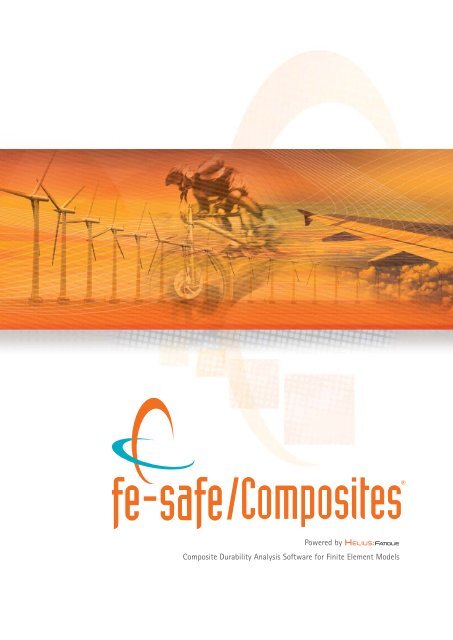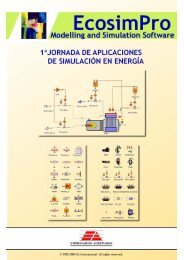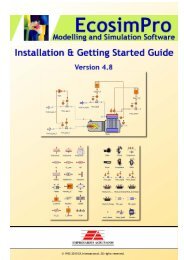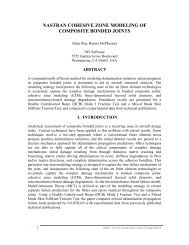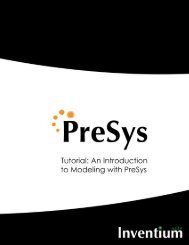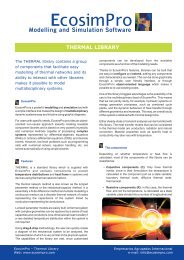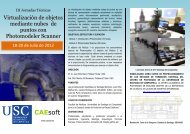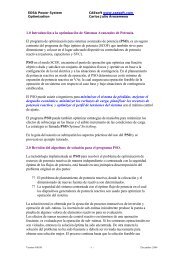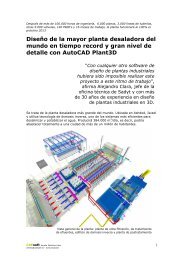Powered by Composite Durability Analysis Software for ... - Caesoft
Powered by Composite Durability Analysis Software for ... - Caesoft
Powered by Composite Durability Analysis Software for ... - Caesoft
You also want an ePaper? Increase the reach of your titles
YUMPU automatically turns print PDFs into web optimized ePapers that Google loves.
<strong>Powered</strong> <strong>by</strong><br />
<strong>Composite</strong> <strong>Durability</strong> <strong>Analysis</strong> <strong>Software</strong> <strong>for</strong> Finite Element Models
Overview<br />
Safe Technology is the technical leader in the design and<br />
development of durability analysis software and is<br />
dedicated to meeting its customers' most demanding<br />
applications. It develops and sells fe-safe ® , the leading<br />
fatigue analysis software suite <strong>for</strong> Finite Element models.<br />
As a privately owned company, its independence and focus<br />
enables Safe Technology to continually bring the most<br />
accurate and advanced fatigue analysis technology<br />
to real-world, industrial applications.<br />
Firehole <strong>Composite</strong>s is a global leader in advanced<br />
composite analysis and in transferring technology into<br />
commercial software. Since its founding in 2000, Firehole’s<br />
mission has been to enable wide-spread use of composite<br />
materials leading to lighter, stronger and more fuel efficient<br />
designs. It offers a suite of products designed to<br />
significantly improve the composite design process.<br />
Safe Technology has partnered with Firehole <strong>Composite</strong>s<br />
to bring to market fe-safe/<strong>Composite</strong>s ® , a unique and<br />
advanced solution enabling the fatigue analysis<br />
of composite materials.<br />
Introduction<br />
<strong>Composite</strong>s are an attractive material option <strong>for</strong> designers<br />
and manufacturers because of their high strength and<br />
stiffness to weight ratio, as well as the ability to tune the<br />
material properties <strong>for</strong> specific applications. As their use<br />
becomes more widespread, there is an increasing need to<br />
understand their behaviour and design life. Until now, an<br />
accurate and robust fatigue life prediction tool <strong>for</strong><br />
composites has not been available.<br />
Predicting fatigue life in composites is challenging because<br />
even simple load states lead to complex behaviour in the<br />
individual composite constituents. Furthermore, the effects<br />
of frequency and load history can only be dealt with<br />
adequately <strong>by</strong> using physics-based theories.<br />
fe-safe/<strong>Composite</strong>s ® meets these challenges head-on <strong>by</strong><br />
combining Multicontinuum Theory with kinetic theory to<br />
introduce a game-changing technology <strong>for</strong> fatigue life<br />
prediction in composite structures.<br />
<strong>Composite</strong> <strong>Durability</strong> <strong>Analysis</strong> <strong>Software</strong> <strong>for</strong> Finite Element Models<br />
Summary<br />
fe-safe/<strong>Composite</strong>s ®<br />
is a robust and computationally efficient tool <strong>for</strong><br />
predicting fatigue life in composite structures<br />
consisting of unidirectional laminae<br />
predicts lamina-level fatigue life at every integration<br />
point in a Finite Element model<br />
predicts fatigue failure <strong>by</strong> applying kinetic theory<br />
to constituent-level stresses<br />
applies realistic physics to naturally account <strong>for</strong> the<br />
effects of frequency, mean stress and combined loading<br />
requires only standard, static material properties and<br />
minimal fatigue characterisation<br />
can handle arbitrarily complex load histories<br />
Key benefits<br />
Efficient, multiscale analysis <strong>for</strong> unidirectional<br />
composite structures<br />
Superior insight into composite fatigue behaviour<br />
Optimised designs with accurate simulation capability,<br />
minimising the need <strong>for</strong> over-design<br />
Reduced composite FEA simulation time<br />
due to computational efficiency<br />
Reduced cost and time-to-market with reduced need<br />
<strong>for</strong> physical testing<br />
Easy implementation with intuitive GUI and seamless<br />
integration with leading FEA packages<br />
Offers a practical tool <strong>for</strong> investigating multiple designs<br />
and complex loading conditions<br />
while minimising costly build<br />
and test cycles<br />
UAV wing<br />
Combining Multicontinuum Theory with kinetic theory<br />
to introduce unique, game-changing technology<br />
Formula 1<br />
car wing
Why use<br />
fe-safe/<strong>Composite</strong>s ®?<br />
<strong>Composite</strong>s are intrinsically different from metals<br />
and require a different approach to fatigue analysis.<br />
Key differences between metals and fibre-rein<strong>for</strong>ced<br />
composites drive physically different load responses:<br />
<strong>Composite</strong>s have multiple constituents with unique<br />
material properties contributing separately to the load<br />
response, so the composite stress and the constituent<br />
stress are not the same<br />
<strong>Composite</strong> behaviour is directionally dependant<br />
because it is influenced <strong>by</strong> the orientation of the fibres<br />
and surrounding laminae<br />
Most of the fatigue damage in composites is<br />
accumulated as microcracks in the matrix material<br />
This results in characteristically different responses<br />
to fatigue loading.<br />
Metal fatigue failure is characterised <strong>by</strong> slow crack<br />
propagation - cracks initiate and propagate in a series of<br />
notch blunting and crack propagation events. By contrast,<br />
composite fatigue failure is a diffuse accumulation of<br />
damage, including multiple damage modes and complex<br />
failure mechanisms.<br />
This fundamental difference in material response requires a<br />
different approach to be used <strong>for</strong> the analysis of composite<br />
fatigue. Traditional metal analysis methods are not<br />
applicable to composites.<br />
Technology overview<br />
<strong>Powered</strong> <strong>by</strong> from Firehole <strong>Composite</strong>s,<br />
fe-safe/<strong>Composite</strong>s ® provides the only commercial solution<br />
available that can extract constituent stresses <strong>for</strong> use with<br />
physics-based fatigue theories without substantial<br />
computational cost or the need <strong>for</strong> exotic material data.<br />
Fatigue failure in fibre-rein<strong>for</strong>ced polymer composites (FRPs)<br />
is generally driven <strong>by</strong> failure in the matrix constituent [1, 2, 3] .<br />
As such, polymer kinetics provides an effective means <strong>for</strong><br />
predicting fatigue life in composites. This approach requires<br />
the behaviour of individual constituent materials of the<br />
composite to be handled separately. fe-safe/<strong>Composite</strong>s ®<br />
has the solution.<br />
uses Multicontinuum Theory (MCT)<br />
to calculate the stress and strain of the fibre and matrix,<br />
allowing fatigue damage to be modelled at the constituent<br />
level rather than <strong>for</strong> the homogenised composite.<br />
employs the kinetic theory of fracture<br />
as a physics-based method <strong>for</strong> predicting fatigue using the<br />
calculated matrix stress.<br />
uses an efficient, multi-scale<br />
decomposition which enables constituent-based analysis<br />
of large-scale structural models with negligible<br />
computational burden.<br />
Proven technology<br />
The MCT technology used in is well<br />
documented and has undergone numerous validation<br />
exercises in government and industry [4,5] . The physics-based<br />
fatigue methodology is based on the well established<br />
kinetic theory of fracture.<br />
<strong>Composite</strong><br />
MCT<br />
Fibre Stresses<br />
Matrix Stresses<br />
Enabling composite fatigue analysis at the constituent level<br />
Traditional metal fatigue analysis methods are not applicable to composites<br />
<strong>Composite</strong> <strong>Durability</strong> <strong>Analysis</strong> <strong>Software</strong> <strong>for</strong> Finite Element Models
Process overview Key features<br />
Two distinct operations are used <strong>by</strong> fe-safe/<strong>Composite</strong>s ®<br />
to predict the fatigue life in a composite structure:<br />
Material characterisation<br />
Static properties of the composite lamina and its<br />
constituents are used with Multicontinuum Theory<br />
to characterise the material<br />
Two S-N curves <strong>for</strong> the lamina are used to<br />
characterise two different failure modes: off-axis<br />
and on-axis<br />
Fatigue life prediction<br />
Constituent stresses are accurately calculated<br />
from the average lamina-level stress at each<br />
integration point in an FEA model using<br />
Multicontinuum Theory<br />
Constituent stresses are converted to an equivalent<br />
fatigue stress<br />
The equivalent fatigue stress is used in the kinetic<br />
theory equations to predict composite fatigue life<br />
The result is a determination of cycles to failure at<br />
every element, node or integration point, presented<br />
as a contour plot <strong>for</strong> the structure.<br />
<strong>Analysis</strong> Example<br />
In this example, fe-safe/<strong>Composite</strong>s ® is used to predict the interlaminar<br />
fatigue response of a short beam shear specimen. Although the<br />
loading results in a complex, shear-based delamination failure,<br />
fe-safe/<strong>Composite</strong>s ® demonstrates that accurate analysis<br />
is achievable using standard tensile S-N data.<br />
Computationally efficient<br />
Designed specifically <strong>for</strong> the analysis of composite<br />
materials, Multicontinuum Theory has been shown to add<br />
only 3% to the computational time required <strong>for</strong> a largescale<br />
structural analysis. Thus, fe-safe/<strong>Composite</strong>s ® offers a<br />
practical tool <strong>for</strong> investigating multiple design and loading<br />
conditions while keeping costly test cycles to a minimum.<br />
Requires only industry-standard material data<br />
The fe-safe/<strong>Composite</strong>s ® approach uses standard material<br />
data and S-N curve data that can be readily determined from<br />
coupon testing or handbook values of unidirectional lamina.<br />
Helius Material Manager<br />
In order to properly characterise a composite material <strong>for</strong><br />
fatigue analysis, composite and constituent properties<br />
must be determined.<br />
Helius Material Manager is a user-friendly tool installed<br />
with fe-safe/<strong>Composite</strong>s ® that is designed to help complete<br />
this characterisation. Helius Material Manager:<br />
utilises a high-speed micromechanics model to assess<br />
the consistency of constituent properties<br />
has a robust nonlinear solver to “back out” constituent<br />
properties from composite properties<br />
contains default values <strong>for</strong> constituent properties<br />
if they are not known<br />
Combines key fe-safe ® features<br />
with technology<br />
The fatigue analysis can be applied to named element groups<br />
on the model. This enables the user to combine the analysis<br />
of composites and the analysis of metals on the same<br />
component and in one analysis.<br />
Accurate fatigue analysis of composites with the comprehensive<br />
capabilities of fe-safe ® to analyse complex loading conditions<br />
<strong>Composite</strong> <strong>Durability</strong> <strong>Analysis</strong> <strong>Software</strong> <strong>for</strong> Finite Element Models<br />
fe-safe/<strong>Composite</strong>s ® requires only standard material inputs:<br />
Elastic Constants ( E 11, E 22, v 12, v 23, G 12)<br />
Ultimate Strengths (± S 22, S 12)<br />
2 lamina S-N curves: 1 longitudinal and 1 transverse
Capabilities overview<br />
FEA models<br />
Inputs are elastic stresses so that the results can be scaled<br />
and superimposed to produce service stress time histories<br />
<strong>Analysis</strong> of solid and shell elements, which can be mixed in<br />
the same model. No effective in-built limit to the number<br />
of elements in the model or the file size. 64-bit file readers<br />
allow large files to be analysed<br />
FEA results from several files can be concatenated<br />
Interfaces to ABAQUS (.fil & .odb), ANSYS (.rst), MSC.Nastran (.op2<br />
& .f06), NX Nastran (.op2 & .f06), NEiNastran (.op2 & .f06),<br />
Pro/Mechanica (ASCII & binary), I-deas (.unv), ADAMS, .dac, MTS<br />
RPCIII (.rsp), BEASY, FEMSYS, CADFIX, MSC.Patran, Altair HyperMesh<br />
& Optistruct. All interfaces included as standard<br />
Intelligent pre-scanning and load case selection, meaning that<br />
the whole model file need not be read into fe-safe ®.<br />
Inputs<br />
Standard material properties <strong>for</strong> the composite lamina<br />
Elastic constants (E 11 , E 22 , v 12 , v 23 , G 12 )<br />
Strengths (±S 22 , S 12 )<br />
Fibre volume fraction<br />
Two lamina S-N curves: one off-axis, one on-axis<br />
Component loading<br />
fe-safe ® can analyse very complex load conditions.<br />
<strong>Composite</strong> fatigue life <strong>for</strong> any mechanical load history with<br />
load-time data can be predicted<br />
A time history of component loading can be applied to the<br />
results of a ‘unit load’‚ linear elastic FEA analysis<br />
Time histories of multiaxial loading can be superimposed<br />
to produce a time history of the stress tensor at each<br />
location on the model (fe-safe ® supports over 4000 load<br />
histories of unlimited length)<br />
A sequence of FEA stresses can be analysed<br />
Complex test programmes and 'proving ground' sequences<br />
can be produced easily<br />
High and low frequency loading can be superimposed<br />
with automatic sample rate matching <strong>by</strong> interpolation<br />
Supported file <strong>for</strong>mats include .DAC, single and<br />
multi-channel ASCII, Safe Technology .amc file,<br />
RPCIII, Servotest, Snap-Master and other files. All file<br />
<strong>for</strong>mats are read directly, without file converters<br />
These load conditions can be combined and superimposed with great<br />
flexibility. PSDs, dynamics, rainflow matrices and other capabilities<br />
are included.<br />
Calculated cycles to failure<br />
Calculated <strong>for</strong> each individual cycle<br />
Calculated using the kinetic theory of fracture to determine<br />
failure in the matrix constituent<br />
Predicted <strong>for</strong> two failure modes:<br />
Matrix damage parallel to fibres (transverse)<br />
Matrix damage perpendicular to fibres that leads<br />
to fibre failure (longitudinal)<br />
Material data<br />
Helius Material Manager is a stand alone tool that is<br />
included with fe-safe/<strong>Composite</strong>s ®<br />
Helius Material Manager can be used to calculate a set<br />
of composite and constituent material properties <strong>for</strong> use<br />
in fe-safe/<strong>Composite</strong>s ®<br />
A comprehensive database of material properties is provided<br />
The material properties in fe-safe ® can be extended and<br />
modified <strong>by</strong> the user<br />
Isothermal data <strong>for</strong> any temperature can be used<br />
<strong>Composite</strong> <strong>Durability</strong> <strong>Analysis</strong> <strong>Software</strong> <strong>for</strong> Finite Element Models<br />
Advanced features<br />
High temperature fatigue included as standard - the user<br />
can define a material characterised at a selected temperature<br />
Comprehensive management of element and node groups<br />
is supported<br />
The fatigue analysis can be applied to the complete model,<br />
or to named element groups - this means the user can<br />
combine the analysis of composites in fe-safe/<strong>Composite</strong>s ®<br />
and the analysis of metals using the algorithms in fe-safe ®<br />
standard, in one single analysis<br />
Different properties can be used <strong>for</strong> each element or node group<br />
The user can easily change any of the inputs and re-run<br />
the analysis, ideal <strong>for</strong> parametric studies<br />
Standard analyses can be set up and re-run easily, ideal <strong>for</strong><br />
parametric studies<br />
Powerful batch processing, with parameter modification <strong>for</strong><br />
sensitivity studies<br />
Output<br />
All contour plots can be generated in a single analysis run.<br />
Cycles to failure and failure mode at each node or element,<br />
shown as a contour plot of the structure in the FEA viewer<br />
Fatigue lives at each node or element (3D contour plot)<br />
in user-defined units, e.g. miles, flights, hours<br />
A text file of user inputs, analysis type and a results summary<br />
is produced <strong>for</strong> QA trace-back<br />
Additional groups of elements can be defined in fe-safe ®<br />
as the hot-spots are identified<br />
Signal processing and analysis<br />
fe-safe/<strong>Composite</strong>s ® includes all the safe4fatigue features <strong>for</strong> signal<br />
processing and fatigue analysis from measured data<br />
Digital filters, spike removal and noise shaping<br />
Interactive multi-channel editing with immediate graphics display<br />
Single and multi-channel peak/valley time-slicing with cycle omission<br />
Manipulation and powerful re-scale/combine functions<br />
<strong>for</strong> signals, cycle matrices and load spectra<br />
Full suite of amplitude and frequency analysis,<br />
including rainflow cycle counting, PSDs, transfer functions<br />
Comprehensive fatigue analysis from strain gauges, including<br />
a full multiaxial fatigue analysis suite<br />
Fully featured graphics display and hard copy<br />
Print graphics to disk, copy and paste graphics to other<br />
MS Windows programs<br />
Additional features<br />
Comprehensive online help<br />
Common user interface across all supported plat<strong>for</strong>ms<br />
Licensing<br />
fe-safe ® is supported on Windows, Linux and UNIX<br />
fe-safe/<strong>Composite</strong>s ® is currently supported on Windows only<br />
Networked licence manager/controller<br />
Distributed processing - rapid analysis using multiple<br />
licences <strong>for</strong> distributed processing across a network<br />
This is not a complete list of features in fe-safe/<strong>Composite</strong>s ®. To discuss your particular requirements, please contact Safe Technology Limited or your local fe-safe/<strong>Composite</strong>s ® representative.
References<br />
1. M. Kawai, S. Yajima, A. Hachinohe, and Y. Takano, “Off-axis fatigue behaviour of unidirectional carbon fibre-rein<strong>for</strong>ced composites at room and high temperatures,” Journal of <strong>Composite</strong> Materials, vol. 35, 2001, pp. 545-576<br />
2. J. Awerbuch and H. Hahn, “Off-axis fatigue of graphite/epoxy composite,” Fatigue of Fibrous <strong>Composite</strong> Materials, San Francisco: ASTM, 1981, pp. 243-273<br />
3. J. Petermann and A. Plumtree, “A unified fatigue failure criterion <strong>for</strong> unidirectional laminates,” <strong>Composite</strong>s: Part A, vol. 32, 2001, pp. 107-118<br />
4. E. Nelson, A. Hansen, J. Welsh, and J. Mayes. “Recent Advances in Failure Predictions of <strong>Composite</strong> Laminates Using Multicontinuum Technology,” Proceedings of the 49th AIAA SDM Conference, Schaumburg, Illinois: 2008<br />
5. Mayes, J.S. and Hansen A.C. (2004) “A Comparison Of Multicontinuum Theory Based Failure Simulation With Experimental Results” Part B of the World-Wide Failure Exercise sponsored <strong>by</strong> DERA, Great Britain. <strong>Composite</strong>s Science<br />
and Technology, 64(3-4), 517-527<br />
Safe Technology Limited<br />
Willis House, Peel Street, Sheffield, S10 2PQ, UK<br />
Tel: +44 (0) 114 268 6444 Fax: +44 (0) 114 303 0055<br />
Email: info@safetechnology.com Website: www.safetechnology.com<br />
All trademarks are acknowledged. fe-safe®, fe-safe/<strong>Composite</strong>s® and the Safe Technology logo are trademarks of Safe Technology Limited.<br />
Microsoft Windows® is a registered trademark of Microsoft Corporation.<br />
With thanks to Firehole Technologies <strong>for</strong> images supplied.<br />
Design <strong>by</strong> bluestrawberryelephant.co.uk ©2011. All rights reserved Safe Technology Limited 2011.


